There’s a special magic in transforming a few simple pantry staples into a pile of fresh, silky pasta. Far from being a complicated culinary feat, making pasta from scratch is a rewarding, hands-on experience that any home cook can master. This detailed guide will walk you through every step, ensuring your first attempt at homemade pasta is a delicious success.
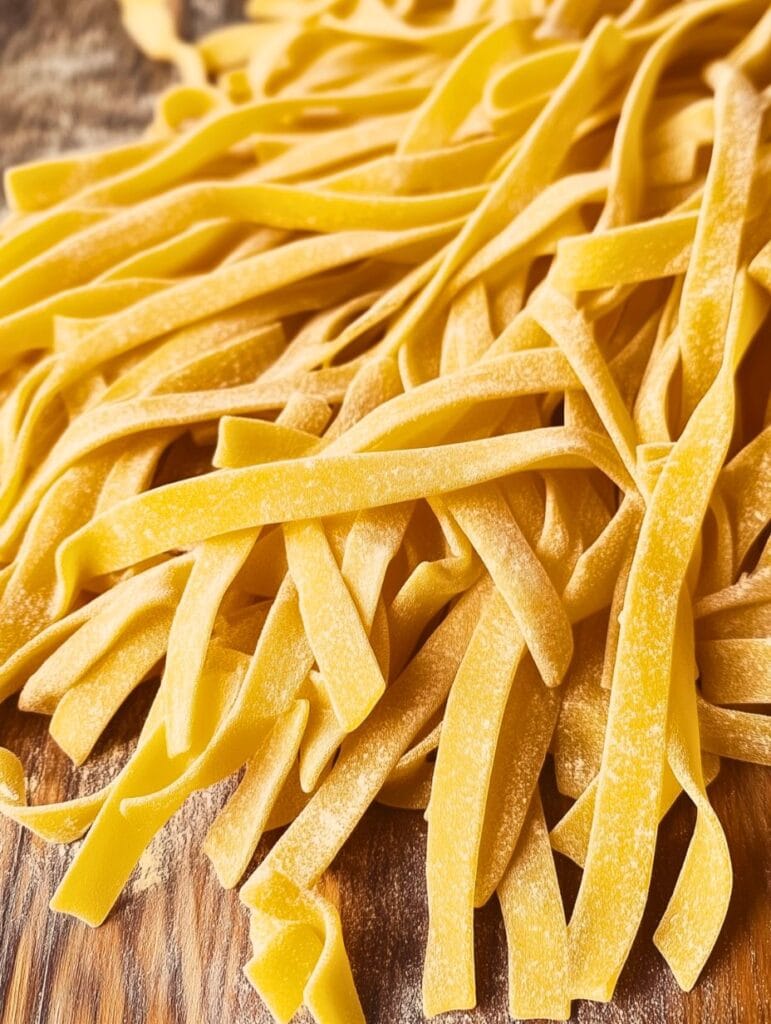
Cuisine: Italian
Prep Time: 20 minutes
Rest Time: 10 minutes
Cooking Time: 2-4 minutes
Total Time: 35 minutes
Servings: 4
Here’s a great video that shows the process of making easy homemade pasta.
Why You’ll Love Making It
- Authentic Italian Flavor: Fresh pasta possesses a delicate, silky texture that cradles sauces in a way dried pasta simply can’t.
- Amazingly Simple: With just four common ingredients and step-by-step instructions, this recipe is perfect for first-time pasta makers.
- Completely Customizable: Shape the dough into your favorite pasta style. You can even infuse it with herbs or spinach for a pop of color and flavor.
- Cooks in Minutes: Fresh pasta cooks much faster than dried varieties, making it a quick option for a weeknight dinner.
- No Special Equipment Needed: While a pasta machine is helpful, a simple rolling pin and a knife are all you truly need to create beautiful, rustic pasta.
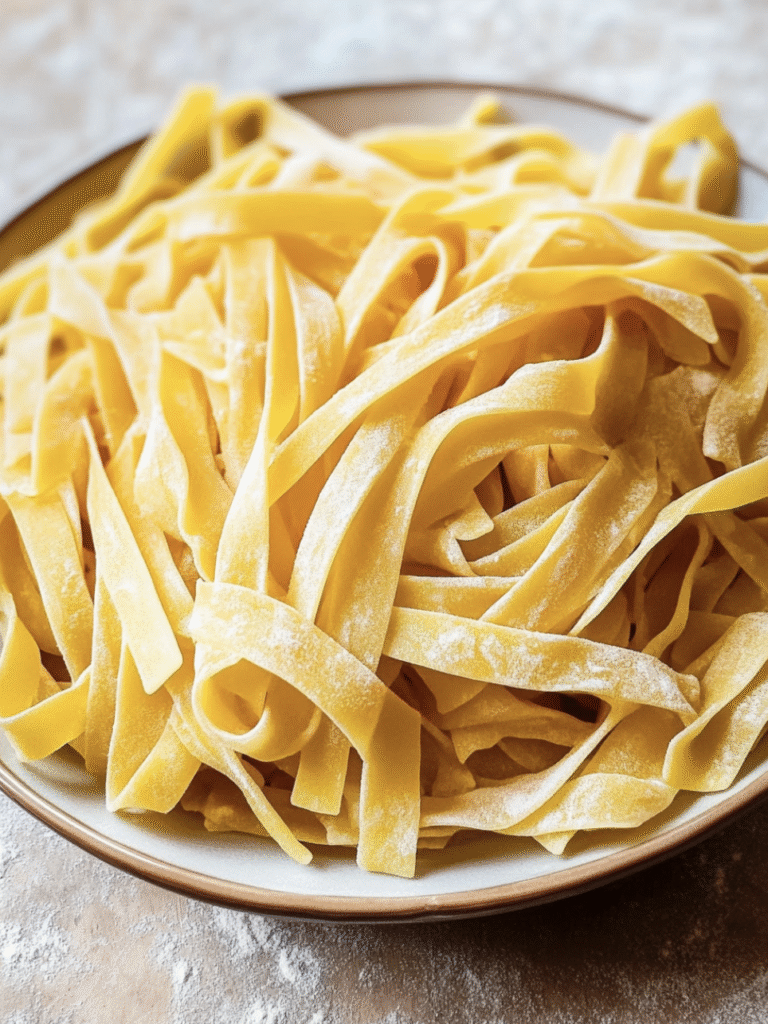
Ingredients
- 2 cups (250g) All-Purpose Flour (or “00” Flour): This is the base of your pasta. While all-purpose flour works wonderfully and creates a chewy, bouncy noodle, Italian “00” flour can also be used. This finely milled flour will produce an even softer, silkier pasta.
- 3 Large Eggs, at room temperature: Eggs provide the necessary moisture, richness, and structure to the dough. Using room temperature eggs helps them incorporate more easily into the flour.
- 2 tablespoons Olive Oil: A splash of olive oil adds flavor, moisture, and elasticity, which helps prevent the dough from drying out.
- 1 teaspoon Salt: Essential for enhancing the flavor of the pasta dough.
- 2 tablespoons Water, or as needed: This is used to adjust the dough’s consistency if it feels too dry.
Instructions
Step 1: Prepare the Dough
On a clean counter or large wooden board, pour the flour into a mound. Using your fingers, create a deep well in the center—think of it as a volcano. Make sure the walls of the well are thick enough to contain the wet ingredients.
Crack the eggs into the well, then add the olive oil and salt. With a fork, gently whisk the eggs, slowly pulling in flour from the inner walls of the well. Continue incorporating the flour until a thick, shaggy dough begins to form. If the dough seems too dry and won’t come together, add water one teaspoon at a time.
Beginner’s Tip: If you’re worried about the egg mixture spilling, you can start this process in a large bowl. Once the dough becomes too stiff to mix with a fork, transfer it to a floured surface to begin kneading.
Step 2: Knead the Dough
Dust your work surface with a little flour. Gather the shaggy dough into a ball and begin to knead. Press the dough forward with the heel of your hand, then fold it over on itself, rotate it slightly, and repeat.
Knead for 8 to 10 minutes. At first, the dough will feel dry and stiff, but be patient. As you work it, the gluten will develop, and the dough will transform into a smooth, elastic, and supple ball. When it’s ready, the dough should feel firm and spring back slowly when you poke it.
Pro-Tip: If the dough feels sticky, add a very small amount of flour to your hands and the surface. Avoid adding too much flour, as this can result in tough pasta.
Step 3: Rest the Dough
Wrap the kneaded dough tightly in plastic wrap or cover it with a damp kitchen towel. Let it rest at room temperature for at least 30 minutes. This crucial step allows the gluten to relax, making the dough much easier to roll out.
Step 4: Roll and Cut the Pasta
Unwrap the dough and divide it into 4 equal portions, keeping the pieces you aren’t working with covered to prevent them from drying out.
By Hand: On a lightly floured surface, use a rolling pin to roll out one portion of dough as thinly as possible, aiming for a thickness of about 1/16th of an inch. Dust the sheet with flour, loosely roll it up like a jelly roll, and use a sharp knife to slice it into your desired width (thin for spaghetti, wider for fettuccine). Gently unroll the noodles and toss them with a bit more flour.
With a Pasta Machine: Flatten a portion of dough so it can fit into your machine. Starting at the widest setting, pass the dough through the rollers. Fold the dough into thirds, like a letter, and pass it through the widest setting again. Repeat this process 2-3 times to smooth out the dough. Continue passing the dough through the machine, narrowing the setting one notch at a time, until you reach your desired thickness. Then, use the cutter attachment to create noodles.
Step 5: Cook the Pasta
Bring a large pot of generously salted water to a rolling boil. Add the fresh pasta and stir gently to prevent sticking. Fresh pasta cooks very quickly, usually in just 2-4 minutes, depending on its thickness. Start tasting it after 2 minutes to check for doneness. It should be “al dente”—tender but with a slight, pleasant chew. Drain immediately and toss with your favorite sauce.
FAQs
Can I make pasta dough without a pasta machine?
Absolutely! A rolling pin is the traditional tool. Roll the dough as thinly and evenly as you can on a floured surface, then use a sharp knife or a pizza cutter to slice it into strips. The pasta will have a more rustic texture, which is just as delicious.
How do I store homemade pasta?
Short-Term (Refrigerator): If you plan to cook it within a day, you can refrigerate the pasta. Dust the noodles generously with flour, arrange them in a single layer on a baking sheet, and cover. It’s best used within 18-24 hours.
Long-Term (Freezer): To freeze, first let the pasta air dry on a floured baking sheet for about an hour. Then, you can either form loose nests or leave the strands straight and place them in an airtight freezer bag or container. It can be frozen for up to a month and should be cooked directly from frozen—do not thaw it first.
Why is my pasta dough too dry or too sticky?
Too Dry: The dough might not have enough moisture. Add water, just a teaspoon at a time, and continue kneading until it comes together.
Too Sticky: The dough has too much moisture. Sprinkle a little flour on your work surface and hands as you knead. Be careful not to add too much, which can make the pasta tough.
What sauces work best with fresh pasta?
Because of its delicate texture, fresh pasta shines with simple sauces. Classic choices include a simple tomato and basil sauce, pesto, or a brown butter and sage sauce. It’s also fantastic with just a drizzle of good olive oil and a sprinkle of Parmesan cheese.
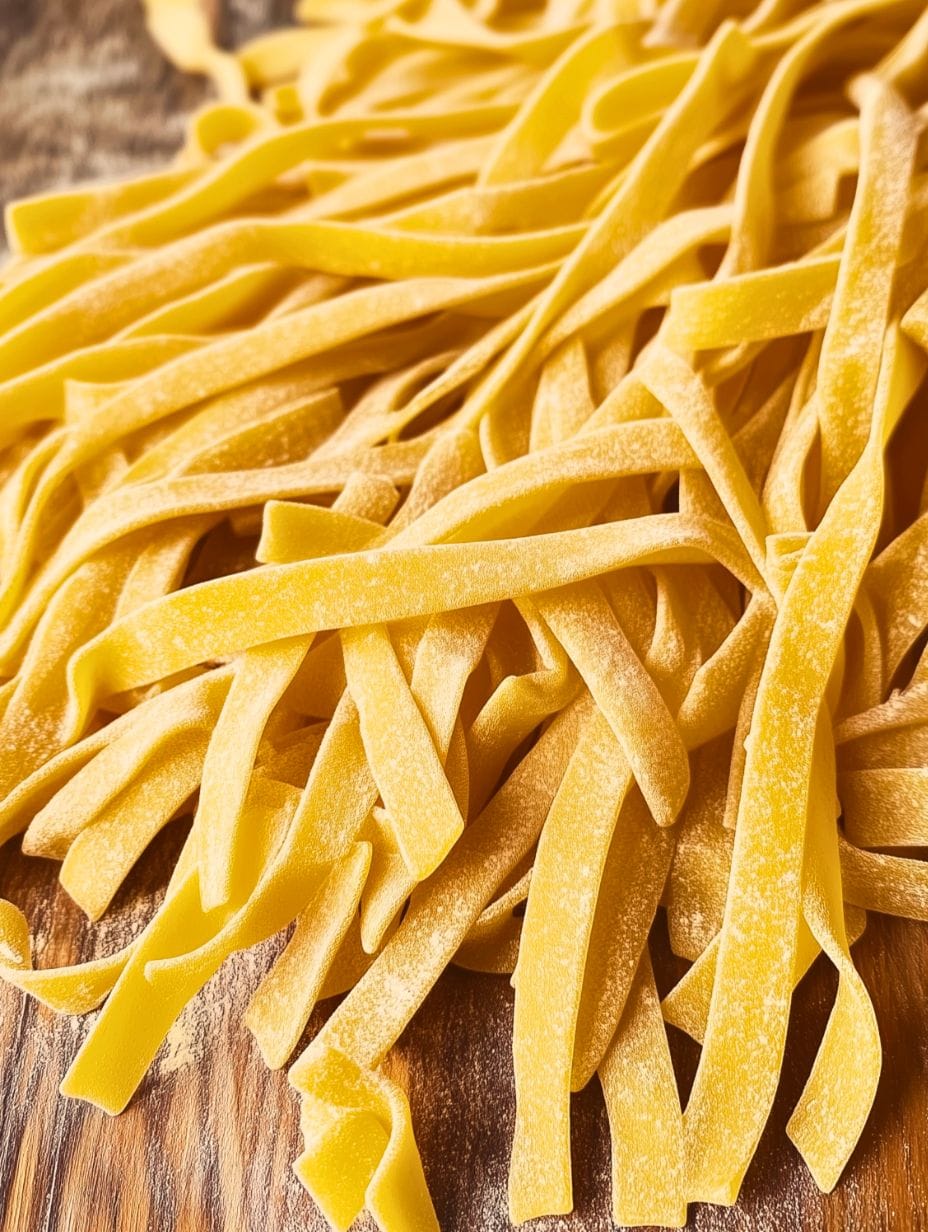
Easy Homemade Pasta
Equipment
- test
- test
Ingredients
- 2 cups All-Purpose Flour
- 3 Large Eggs
- 2 tbsp Olive Oil
- 1 tsp Salt
- 2 tbsp Water
Instructions
- On a clean counter or large wooden board, pour the flour into a mound. Using your fingers, create a deep well in the center—think of it as a volcano. Make sure the walls of the well are thick enough to contain the wet ingredients.Crack the eggs into the well, then add the olive oil and salt. With a fork, gently whisk the eggs, slowly pulling in flour from the inner walls of the well. Continue incorporating the flour until a thick, shaggy dough begins to form. If the dough seems too dry and won’t come together, add water one teaspoon at a time.Beginner’s Tip: If you’re worried about the egg mixture spilling, you can start this process in a large bowl. Once the dough becomes too stiff to mix with a fork, transfer it to a floured surface to begin kneading.
- Dust your work surface with a little flour. Gather the shaggy dough into a ball and begin to knead. Press the dough forward with the heel of your hand, then fold it over on itself, rotate it slightly, and repeat.Knead for 8 to 10 minutes. At first, the dough will feel dry and stiff, but be patient. As you work it, the gluten will develop, and the dough will transform into a smooth, elastic, and supple ball. When it’s ready, the dough should feel firm and spring back slowly when you poke it.Pro-Tip: If the dough feels sticky, add a very small amount of flour to your hands and the surface. Avoid adding too much flour, as this can result in tough pasta.
- Wrap the kneaded dough tightly in plastic wrap or cover it with a damp kitchen towel. Let it rest at room temperature for at least 30 minutes. This crucial step allows the gluten to relax, making the dough much easier to roll out.
- Unwrap the dough and divide it into 4 equal portions, keeping the pieces you aren’t working with covered to prevent them from drying out.By Hand: On a lightly floured surface, use a rolling pin to roll out one portion of dough as thinly as possible, aiming for a thickness of about 1/16th of an inch. Dust the sheet with flour, loosely roll it up like a jelly roll, and use a sharp knife to slice it into your desired width (thin for spaghetti, wider for fettuccine). Gently unroll the noodles and toss them with a bit more flour.With a Pasta Machine: Flatten a portion of dough so it can fit into your machine. Starting at the widest setting, pass the dough through the rollers. Fold the dough into thirds, like a letter, and pass it through the widest setting again. Repeat this process 2-3 times to smooth out the dough. Continue passing the dough through the machine, narrowing the setting one notch at a time, until you reach your desired thickness. Then, use the cutter attachment to create noodles.
- Bring a large pot of generously salted water to a rolling boil. Add the fresh pasta and stir gently to prevent sticking. Fresh pasta cooks very quickly, usually in just 2-4 minutes, depending on its thickness. Start tasting it after 2 minutes to check for doneness. It should be “al dente”—tender but with a slight, pleasant chew. Drain immediately and toss with your favorite sauce.




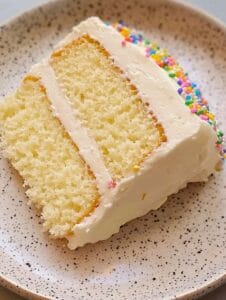
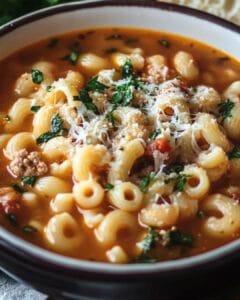

hey, can I use whole wheat flour instead for this pasta recipe? thx!
Making pasta is chill. better than store bought.
Kids gonna turn into pasta one of these days, swear I’m making it so much.
lol same here, pasta diet for my kids!
Pasta is life, kids know what’s up!
Making pasta at home sounds too good to be true. Probably mess it up anyway.
I’ve always wanted to make homemade pasta. This guide makes it seem so doable!
never thought making pasta was this easy, gonna try this weekend.
who even has time to make pasta from scratch? not me.
Is there a specific type of flour that’s best for pasta, or can I use any kind?
Tried this recipe out, and it actually turned out decent. Was surprised.
Actually, resting the dough is crucial in pasta making. It helps the gluten relax which makes the pasta tender.
Absolutely! Noticed a huge difference when I let my dough rest properly.
Love the use of olive oil in this, gives the pasta a nice flavor!
omg making my own pasta? yes please! looks so fun!
Pasta without sauce is like a day without sunshine. Sauce pls?
Love that I can make this without fancy equipment. Saving money is my jam.
Is it possible to substitute with a gluten-free flour blend for those of us with dietary restrictions?
Every time I try making dough, it’s a disaster. Wish me luck with this one.
Sandra Clare, you’re a lifesaver! Homemade pasta has always been on my bucket list. Can’t wait to try this!
The hydration of the dough is crucial. The exact amount of water might vary depending on your flour’s absorption. It’s all about the feel.
Looks like I found my weekend project. Thanks for the inspiration!
Homemade pasta is the only way to go. Store bought can never compare, but let’s see if this recipe holds up.
Remember folks, the protein content in your flour can greatly affect the outcome of your pasta. Not all flours are created equal.
Interesting read. Maybe I’ll try making pasta.